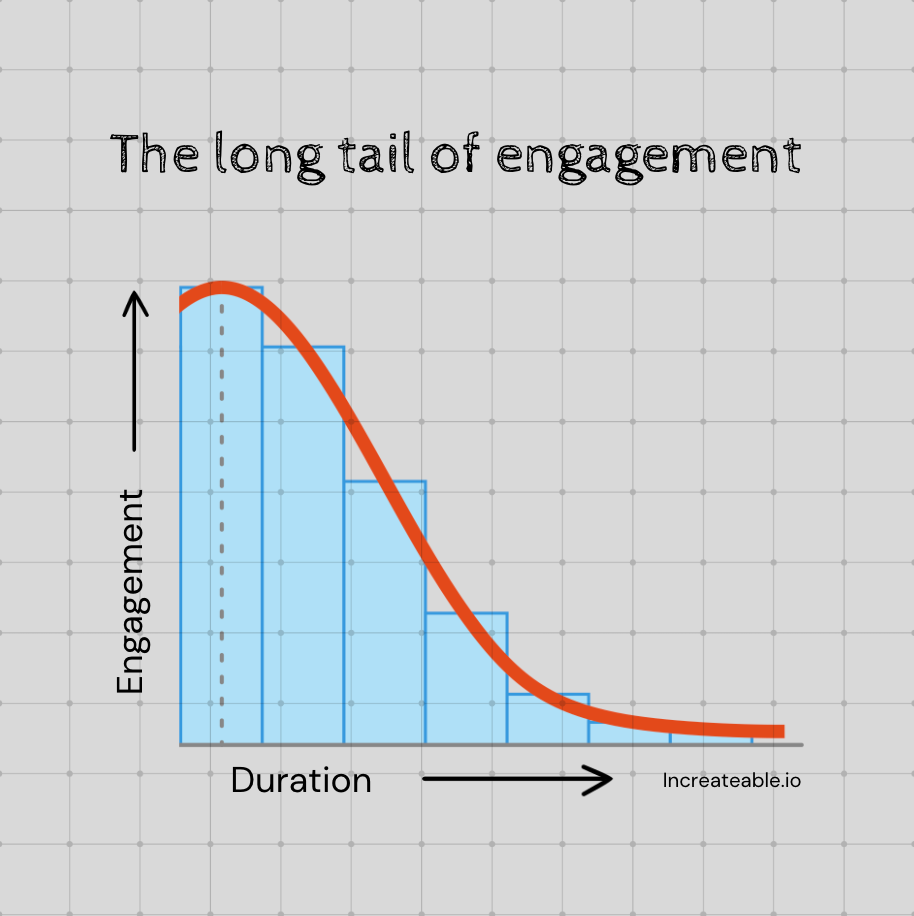The Long Tail of Community
After 20+ years of building communities and watching how people interact within them, I've noticed something that nobody really talks about. I call this phenomenon the long-tail of community.

You know what fascinates me? After 20+ years of building communities and watching how people interact within them, I've noticed something that nobody really talks about. I call this phenomenon the long-tail of community.
It's this pattern that keeps showing up, over and over again, kind of like what Chris Anderson discovered about technology adoption, but in the world of community building.
Let me back up a second and tell you about Anderson's idea. He noticed that technology goes through these predictable phases - there's the early adoption phase, the mainstream phase, and then this long tail where things keep going but at a lower level.
Read it, it's brilliant. Anderson was talking about how the internet changed everything because it let this tail stretch out basically forever.
But here's what people don't know.
Communities follow the exact same long-tail pattern.
Think about the last time you joined a new community. Maybe it was a course, a discord, or even a gym. Remember that initial burst of excitement? Those first days where everything is new and interesting and you can't get enough?
That's not an accident. That's the peak engagement window, and it's incredibly powerful.
During this time, people are like sponges. They want to soak up everything. They're attending events, asking questions, making connections. They're all in.
Then something interesting happens. After a few weeks, there's a focus shift (not an energy shift). The excitement doesn't exactly die, it changes.
People get more selective. They figure out what parts of the community really matter to them. They might not show up to everything anymore, but when they do show up, they're really there for it.
This is where most community builders go wrong. They see this change in behavior and think something's wrong. Nothing's wrong at all. It's completely natural. It's like expecting summer to last all year - it just doesn't work that way (SoCal excluded, obviously).

After three months, people settle into what I call their "natural engagement pattern." Some will drift away entirely. Others will pop in and out. A few will stay highly engaged. But most will fall into this long tail of occasional, purposeful engagement.
You've probably seen this yourself in communities you're part of. Think about it - aren't there some spaces you were really into at first, before settling into a laid-back or intermittent pattern of engagement? That's not a failure of the community - it's a natural evolution of how we engage with groups over time.
There are a few key lessons here:
The stronger you make that initial experience, the stronger the entire tail becomes.
Raise the left side of the curve and the long tail effect is greater. It's like the law of momentum - objects in motion tend to stay in motion. Communities with strong starts tend to maintain stronger engagement throughout the entire cycle.
Standard events don't cut it.
People want specificity and focus in the second phase. You have to find a way to deliver on that need or risk breaking the momentum.
Content creates long-tail opportunities.
This could be live or async or just a course. Content rules as it's accessible to all members, regardless of where they are on the long tail timeline. When they tune in, they want to see new things waiting for them (surprise!).
The long-tail approach supports all member types.
Some folks are crazy engaged. Others never show up. Some just lurk. Others are online 24/7. What do you do!? You long tail it...follow the flow to make sure that there's something for everyone. This keeps you on course and creates long-term value.
Think about it like this: if you know people are naturally going to be super engaged in the first 30 days, you make sure you have plenty of opportunities for engagement during that time. If you know they're going to get more selective after that, you create more focused, specific opportunities. And if you know they're going to move into a long-tail pattern, you build systems that support that too.
Back to that peak engagement window. This is exactly why I'm so fascinated with pop-up communities. They capitalize on that initial high-energy phase. When you know you've only got a short window, you make it count. You create these intense, meaningful experiences that stick with people.
This is why I get frustrated when I see people trying to force constant high-level engagement from everyone. It's like they're fighting against human nature instead of working with it.

The smart move is to embrace this pattern. Build your community with the understanding that people will move through these phases. Create structures that support each phase. Make your peace with the fact that not everyone will stay at peak engagement forever - and that's okay.
Remember what Anderson said about the long tail in technology? How it changed everything because it meant you could serve many more people in different ways? The same is true for communities. When you embrace the long tail of engagement, you can create spaces that serve more people, more effectively, over longer periods of time.
Just something to think about next time you're building or managing a community.
Happy building.
~ Patrick
By the way, I've here's Anderson's full talk on the long tail phenomenon. It's worth watching - not just for the technology insights, but for how eerily similar the patterns are to what we see in community building.
